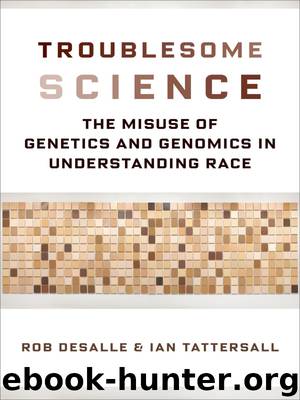Troublesome Science by Rob DeSalle

Author:Rob DeSalle
Language: eng
Format: epub
Tags: SCI029000, Science/Life Sciences/Genetics & Genomics, SOC002000, Social Science/Anthropology/General
Publisher: Columbia University Press
Published: 2018-06-19T04:00:00+00:00
Figure 9.4 Timeline showing the development of whole-genome sequencing for ancient (fossilized modern H. sapiens) and archaic humans (Neanderthals and Denisovans). From Nielsen et al. (2017).
Figure 9.5 MtDNA genome phylogenetic tree (left) and nuclear genome tree (right). The trees are from Ermini (2014), but the Sima de los Huesos data were generated in 2016; hence the arrow indicates the position of the Sima de los Huesos lineage.
Figure 9.6 The ABBA/BABA test. The top tree is the “real” or expected tree. The bottom, left tree is the ABBA tree (French with Neanderthal), and the right tree is the BABA tree (Yoruba with Neanderthal). Individuals are numbered as P1 (Yoruba), P2 (French), P3 (Neanderthal), and P4 (chimpanzee). The agreement of the SNP with the tree is accomplished by examining the state at the node with the star labeled “derived state.”
One simply sifts through the sequence data and assesses for each SNP whether it supports the “real” tree—and, if not, which of the other two trees the SNP supports. The test then compares the tallies for the three trees. The number used to summarize the analysis is called the D statistic, and is given by the simple ratio of the number of ABBA SNPs minus the number of BABA SNPs, divided by the number of ABBA SNPs plus the number of BABA SNPs. If the D statistic is positive, it means that there are more ABBA SNPs than BABA SNPs, and hence that more Neanderthal SNPs resemble Yoruba SNPs. On the other hand, if the D statistic is negative, there are more BABA SNPs, meaning that more SNPs support a Neanderthal-French relationship. If the evolution of all the SNPs is regular, the D statistic should be 0.0. But if there is something odd occurring, a positive or negative D statistic is obtained, and the magnitude of the D number tells us how much hanky-panky is going on. Table 9.1 shows the results of applying the ABBA/BABA test to several modern human individuals. Note that in the D column of the table the only values that are significant are comparisons of non-African with African, and that the values are between D = −3.8 and D = −5.3. These results indicate that there is an excess of Neanderthal-like sequences in non-African genomes.
But what kind of hanky-panky could cause a nonzero D statistic for a comparison? Remember that the nuclear genome undergoes recombination during sexual reproduction. One mechanism might be interbreeding between the Neanderthal and Homo sapiens lineages. This would not be unexpected, since very closely related species are often observed to interbreed if they have the opportunity—even though, if they truly are different species (as seems to have been the case with Neanderthals and ourselves), this behavior will not lead to reintegration of the two lineages. Still, if Neanderthal individuals had mated with members of our species during their brief time of geographic overlap, then part of the Neanderthal genome might have recombined into H. sapiens genomes. In which case, we would expect chunks of the H.
Download
This site does not store any files on its server. We only index and link to content provided by other sites. Please contact the content providers to delete copyright contents if any and email us, we'll remove relevant links or contents immediately.
| Anthropology | Archaeology |
| Philosophy | Politics & Government |
| Social Sciences | Sociology |
| Women's Studies |
Nudge - Improving Decisions about Health, Wealth, and Happiness by Thaler Sunstein(7654)
iGen by Jean M. Twenge(5384)
The Fire Next Time by James Baldwin(5377)
Adulting by Kelly Williams Brown(4529)
The Sports Rules Book by Human Kinetics(4338)
The Hacking of the American Mind by Robert H. Lustig(4334)
The Ethical Slut by Janet W. Hardy(4208)
Captivate by Vanessa Van Edwards(3814)
Mummy Knew by Lisa James(3653)
In a Sunburned Country by Bill Bryson(3503)
The Worm at the Core by Sheldon Solomon(3450)
Ants Among Elephants by Sujatha Gidla(3438)
The 48 laws of power by Robert Greene & Joost Elffers(3131)
Suicide: A Study in Sociology by Emile Durkheim(2989)
The Slow Fix: Solve Problems, Work Smarter, and Live Better In a World Addicted to Speed by Carl Honore(2975)
The Tipping Point by Malcolm Gladwell(2864)
Humans of New York by Brandon Stanton(2847)
Handbook of Forensic Sociology and Psychology by Stephen J. Morewitz & Mark L. Goldstein(2676)
The Happy Hooker by Xaviera Hollander(2671)
